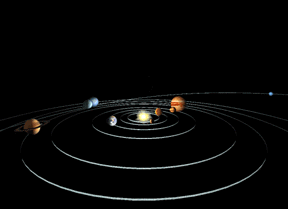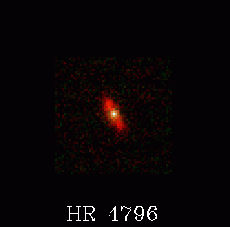This is an image of star HR 4796 in the constellation Centaurus. Two infrared wavelengths have been represented as light blue and red to make this picture. The disk of dust which is believed to have formed planets is seen in red here.
Click on image for full size
Image courtesy of JPL/NASA
WARNING! Planet Construction Zone Ahead!
News story originally written on April 27, 1998
Astronomers have recently found what appears to be the clearest evidence yet of another
solar system. Astronomers used the Keck II telescope in Hawaii to take images of a star called HR 4796 in the constellation
Centaurus. The images show what appears to be a disk of dust around the star. This disk has an empty region in the middle that appears to have been swept clean of material. Scientists think that in this empty area planets could be forming (when planetary bodies form, an area often appears empty because excess material tends to coalesce onto already forming planetary bodies).
The HR 4796 star is 220 light years away from Earth, so there will be no visiting this probable solar system any time soon. However, scientists will continue researching this star because what has been found there is of such significance in adding to our understanding of the formation of our own solar system.
"This may be what our solar system looked like at the end of its main planetary formation phase," said Dr. Michael Werner of JPL, who co-discovered the region, along with Doctors David Koerner and Michael Ressler, also of JPL, and Dana Backman of Franklin and Marshall College. "Comets may be forming right now in the disk's outer portion from remaining debris
You might also be interested in:

Scientists believe that the solar system was formed when a cloud of gas and dust in space was disturbed, maybe by the supernova of a nearby star. Shock waves from the explosion compressed the cloud of
...more
It was another exciting and frustrating year for the space science program. It seemed that every step forward led to one backwards. Either way, NASA led the way to a great century of discovery. Unfortunately,
...more
The Space Shuttle Discovery lifted off from Kennedy Space Center at 2:19 p.m. EST, October 29th. The sky was clear and the weather was great as Discovery took 8 1/2 minutes to reach orbit for the Unitied
...more
A moon was discovered orbiting the asteroid, Eugenia. This is only the second time in history that a satellite has been seen circling an asteroid. A special mirror allowed scientists to find the moon
...more
Will Russia ever put the service module for the International Space Station in space? NASA officials are demanding an answer from the Russian government. The necessary service module is currently waiting
...more
During a period of about two days in early May, 1998, the ACE spacecraft was immersed in plasma associated with a coronal mass ejection (CME). The SWICS instrument on ACE, which determines unambiguously
...more
J.S. Maini of the Canadian Forest Service has referred to forests as the "heart and lungs of the world." Forests reduce soil erosion, maintain water quality, contribute to atmospheric humidity and cloud
...more















